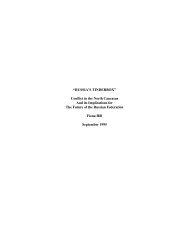The Heart of the Matter Valerie M. Hudson, - MIT Press Journals
The Heart of the Matter Valerie M. Hudson, - MIT Press Journals
The Heart of the Matter Valerie M. Hudson, - MIT Press Journals
You also want an ePaper? Increase the reach of your titles
YUMPU automatically turns print PDFs into web optimized ePapers that Google loves.
<strong>The</strong> <strong>Heart</strong> <strong>of</strong> <strong>the</strong> <strong>Matter</strong> 25<br />
also accentuate <strong>the</strong>ir views <strong>of</strong> women as different, a view reinforced when men<br />
do not feel <strong>the</strong> positive interactions with women <strong>the</strong>y experience when <strong>the</strong>y<br />
are in <strong>the</strong> presence <strong>of</strong> o<strong>the</strong>r men. <strong>The</strong>se dynamics may also be interpreted by<br />
some men as evidence <strong>of</strong> <strong>the</strong> inferiority <strong>of</strong> women, and justiªcation for objectifying<br />
and dehumanizing <strong>the</strong>m.<br />
Female children or women do not appear to have comparable positive samesex<br />
compatibility. This ªnding, coupled with <strong>the</strong> fact that in most societies<br />
women are structurally organized in patrilocal families under <strong>the</strong> direction <strong>of</strong><br />
men, could explain why even when women associate with o<strong>the</strong>r women, <strong>the</strong>ir<br />
allegiance is primarily to <strong>the</strong> male heads <strong>of</strong> <strong>the</strong>ir households. As previously<br />
discussed, this may also be a tragic by-product <strong>of</strong> human evolution as it pertains<br />
to female choice.<br />
Extrapolating from <strong>the</strong> above ªndings, it is logical to suggest that young<br />
male children who see that violence against women rewards <strong>the</strong>ir fa<strong>the</strong>rs are<br />
likely to perpetuate violence in <strong>the</strong>ir own relationships with women, and perhaps<br />
even generalize <strong>the</strong>ir violent responses to all women. Couple <strong>the</strong>se acquired<br />
behaviors in boys with <strong>the</strong> ªndings <strong>of</strong> camaraderie among groups <strong>of</strong><br />
boys, and <strong>the</strong> foundation for emerging groups <strong>of</strong> men treating women poorly<br />
begins to take shape. As aggressive boys gravitate toward each o<strong>the</strong>r, <strong>the</strong>y<br />
acquire more social and political power. <strong>The</strong> group identity <strong>of</strong> such male collectives<br />
is <strong>of</strong>ten streng<strong>the</strong>ned by various initiations and rituals <strong>of</strong>ten dehumanizing<br />
nonmembers and enhancing willingness to use violence against <strong>the</strong>m. 62<br />
Fur<strong>the</strong>rmore, <strong>the</strong>se characteristic group behaviors are used to train new recruits<br />
to carry on in <strong>the</strong> dynamics <strong>of</strong> <strong>the</strong> group across generations.<br />
In cultures where violence against women is allowed to persist, individuals<br />
(particularly male individuals) are committing continual, possibly daily, acts<br />
<strong>of</strong> aggression and violence. Extrapolating from Gerald Patterson’s model,<br />
<strong>the</strong> relative rate <strong>of</strong> reinforcement is a signiªcant predictor for <strong>the</strong> relative rate<br />
<strong>of</strong> aggressive behavior, and <strong>the</strong> rate <strong>of</strong> reinforcement for violence against<br />
women is extremely high, resulting in overlearned violent acts that become<br />
automatic. 63 Fur<strong>the</strong>rmore, Patterson states that boys who engage in high frequencies<br />
<strong>of</strong> antisocial behavior are at a signiªcantly greater risk to commit violent<br />
acts within <strong>the</strong>ir communities. This strongly suggests that violence at<br />
different levels <strong>of</strong> analysis are connected, in that states that allow violence<br />
62. Claudia J. Clayton, Sally H. Barlow, and Bonnie Ballif-Spanvill, “Principles <strong>of</strong> Group Violence<br />
with a Focus on Terrorism,” in Harold V. Hall and Leighton C. Whitaker, eds., Collective Violence:<br />
Effective Strategies for Assessing and Interviewing in Fatal Group and Institutional Aggression (Boca<br />
Raton, Fla.: CRC <strong>Press</strong>, 1999), pp. 277–311.<br />
63. Patterson, “A Comparison <strong>of</strong> Models for Interstate War and for Individual Violence.”
















